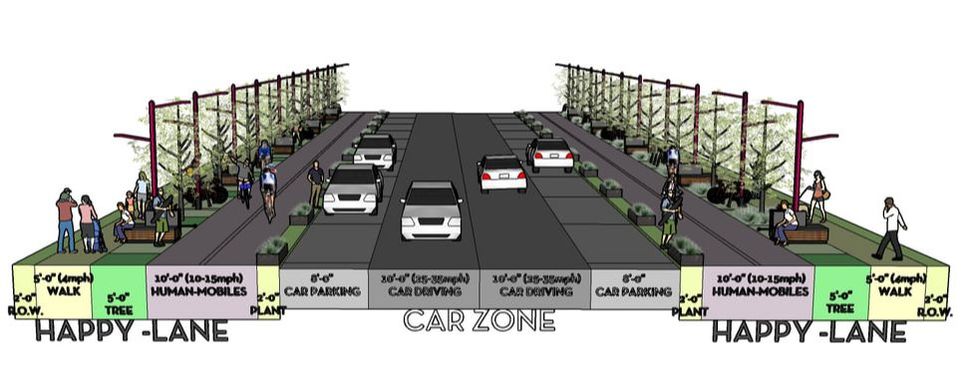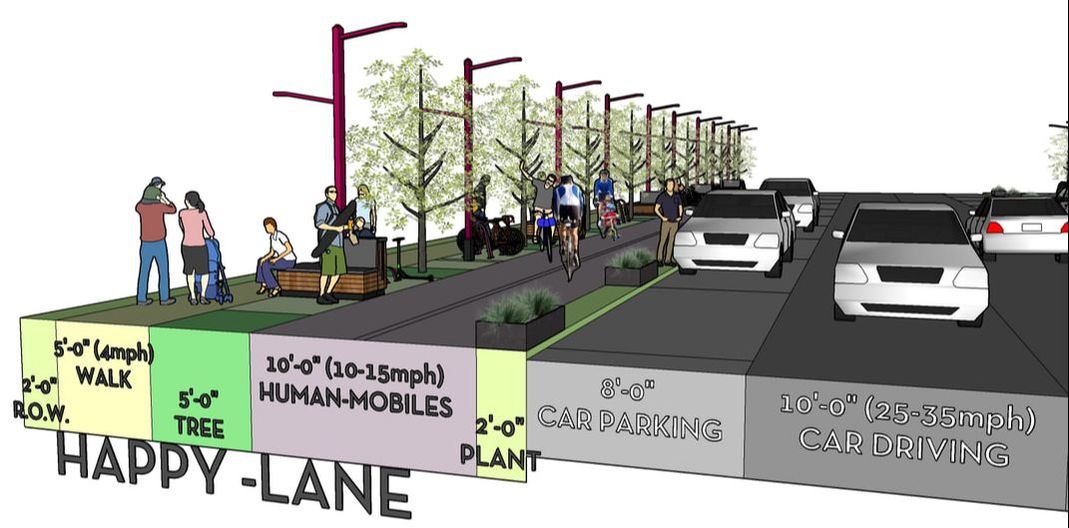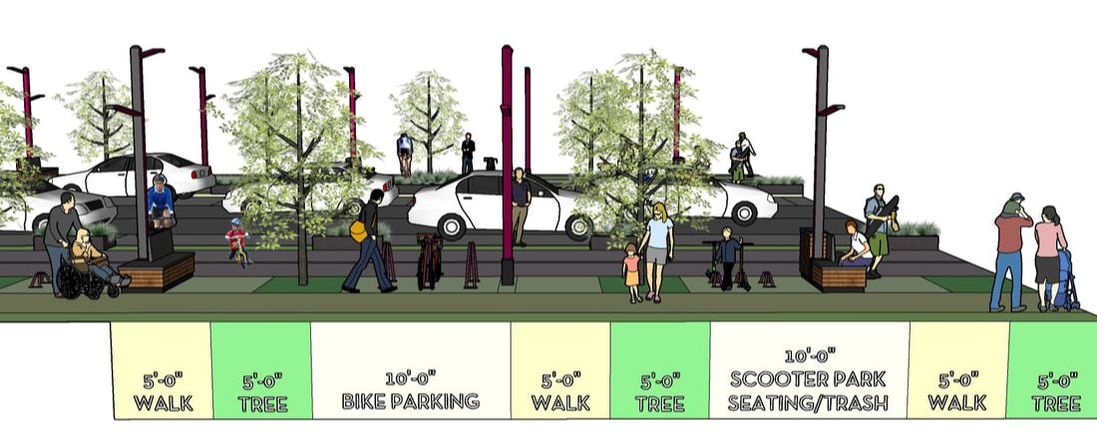A Third Mobility Mode
A few weeks ago, I coined the term "BikeWalk", a “new” transportation/mobility infrastructure concept. The seed for the “Bikewalk!” sprouted after seeing missed opportunities for good bicycle infrastructure in the Bay Area (Bay Meadows, MainStreet Cupertino, Santa Clara Square). While the term "BikeWalk" was new, the idea is actually old hat and already a reality in many cities around the world: Sydney, Taipei, Tokyo. After listening to a recent KQED Forum debate about e-Scooters in San Francisco, and witnessing the convenience of e-Scooters (Bird, Lime, etc), I’m now doubly convinced of the concept and want to expand the idea of a BikeWalk further.
The reality is that the built American landscape only accommodates two modes of transportation: the private automobile (primary), and walking (secondary). Think about it, what traffic lights and signals do we see at intersections? Red/Yellow/Green traffic lights for cars, and a white man/red hand for pedestrians. But today, our communities need to serve and connect so many more people, uses, and spaces, that these two transportation modes alone are no longer efficient, or sufficient.
We need to create a third mobility mode which supports a combination of transportation options: bikes/e-bikes, roller-skates/roller-blades, skateboards/hoverboards, scooters/e-scooters. Heck, let’s even put the Segway in this category. What ties these modes together? Speed and mass.
A few weeks ago, I coined the term "BikeWalk", a “new” transportation/mobility infrastructure concept. The seed for the “Bikewalk!” sprouted after seeing missed opportunities for good bicycle infrastructure in the Bay Area (Bay Meadows, MainStreet Cupertino, Santa Clara Square). While the term "BikeWalk" was new, the idea is actually old hat and already a reality in many cities around the world: Sydney, Taipei, Tokyo. After listening to a recent KQED Forum debate about e-Scooters in San Francisco, and witnessing the convenience of e-Scooters (Bird, Lime, etc), I’m now doubly convinced of the concept and want to expand the idea of a BikeWalk further.
The reality is that the built American landscape only accommodates two modes of transportation: the private automobile (primary), and walking (secondary). Think about it, what traffic lights and signals do we see at intersections? Red/Yellow/Green traffic lights for cars, and a white man/red hand for pedestrians. But today, our communities need to serve and connect so many more people, uses, and spaces, that these two transportation modes alone are no longer efficient, or sufficient.
We need to create a third mobility mode which supports a combination of transportation options: bikes/e-bikes, roller-skates/roller-blades, skateboards/hoverboards, scooters/e-scooters. Heck, let’s even put the Segway in this category. What ties these modes together? Speed and mass.
Segmentation of transportation modes should be based on speed & mass for safety reasons. Walking is about 2-4 mph (15-30 minutes/mile), and while pedestrians may utilize wheeled objects (walkers, strollers, wagons, wheelchairs), the speed of those pedestrians and mass of the wheeled objects will not inflict significant harm on each other in a collision. By gross contrast, cars are 4000 pound (2 ton) wheeled metal objects with powerful motors that travel regularly at 25, 30, 35, even 40 mph. When cars collide with a pedestrian, bicycle or other human operated object, they can cause severe injuries - and the higher the speed, the higher the fatality rate.
Bikes/e-bikes, roller skates/blades, skateboards/hoverboards, scooters/e-scooters, even Segways, are in a different category altogether. These modes are human operated, but not enclosed, and can travel at speeds between 10-15 mph. By law, they are considered “vehicles” and therefore subject to each state’s vehicle codes. But for all practical purposes, they are objects that have neither the weight, bulk, protection, nor speed of private automobiles, vans, trucks or buses. However, the laws of physics decree that people travelling on these wheeled objects would be grievously harmed by 4,000-pound metal objects travelling at 30 miles per hour, but could also cause harm to individuals ambling at 4 miles per hour. (Remember: Force = mass x acceleration)
The first step to create a solution for this third mobility mode is to name this category of vehicles and create the vocabulary and language to describe their properties and requirements. So I hereby name bikes/e-bikes, roller-skates/blades, skateboards/hoverboards, scooters/e-scooters and Segways: “Human-Mobiles” and call the new infrastructure to support them “Happy-Lanes”.
Bikes/e-bikes, roller skates/blades, skateboards/hoverboards, scooters/e-scooters, even Segways, are in a different category altogether. These modes are human operated, but not enclosed, and can travel at speeds between 10-15 mph. By law, they are considered “vehicles” and therefore subject to each state’s vehicle codes. But for all practical purposes, they are objects that have neither the weight, bulk, protection, nor speed of private automobiles, vans, trucks or buses. However, the laws of physics decree that people travelling on these wheeled objects would be grievously harmed by 4,000-pound metal objects travelling at 30 miles per hour, but could also cause harm to individuals ambling at 4 miles per hour. (Remember: Force = mass x acceleration)
The first step to create a solution for this third mobility mode is to name this category of vehicles and create the vocabulary and language to describe their properties and requirements. So I hereby name bikes/e-bikes, roller-skates/blades, skateboards/hoverboards, scooters/e-scooters and Segways: “Human-Mobiles” and call the new infrastructure to support them “Happy-Lanes”.
“Human-Mobiles” can and should be the cornerstone of mobility in the city of the future. This mobility class is characterized by affordability, convenience, compactness, flexibility, and intuition. A HumanMobile is really easy to learn how to use, super convenient for getting from place to place and does not take up a lot of space in our cities to park/store (provided that we intentionally plan for them in our cities).
“Happy-Lanes” can and should be Human Lanes, Hopeful Lanes and Healthy Lanes. They allow people to zip along faster than pedestrians, more nimbly than automobiles, and safely on separated pathways. They fuel an innate human desire to be hopeful, healthy and happy about their mobility possibilities.
If you like this concept and are interested/ serious in making Happy-Lanes for Human-Mobiles (the Third Mobility Mode) a reality, please holler!
“Happy-Lanes” can and should be Human Lanes, Hopeful Lanes and Healthy Lanes. They allow people to zip along faster than pedestrians, more nimbly than automobiles, and safely on separated pathways. They fuel an innate human desire to be hopeful, healthy and happy about their mobility possibilities.
If you like this concept and are interested/ serious in making Happy-Lanes for Human-Mobiles (the Third Mobility Mode) a reality, please holler!




 RSS Feed
RSS Feed